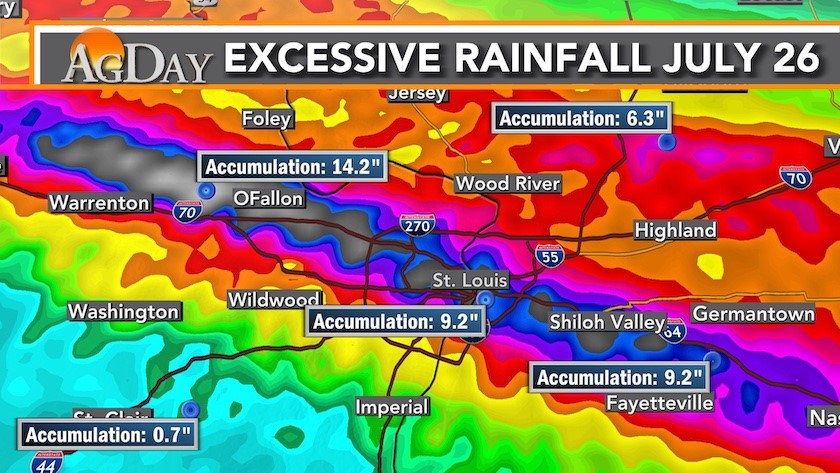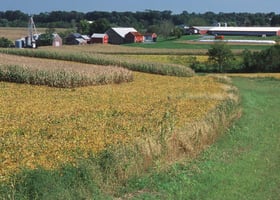Agricultural bankers reported a 22% increase in farmland values in the central Corn Belt during...
What Will 14 Inches of Rain in One Day Do to Crops?


This map from AgDay meteorologist Matt Yarasewick shows just how heavily the rain fell last week. The pocket surrounding Troy, Missouri, saw 14.2 inches of rain. The narrow band caused historic totals in some areas. The map indicates the system also dropped more than 9 inches of rain in areas on both sides of the state line surrounding St. Louis, Missouri. However, by contrast, St. Clair, which is located an hour south of Troy, saw only 0.7 inches of rain. For those areas shaded in black, blue and purple, the rainfall was devastating to crops.
From drought to flooding overnight, fields located northwest of St. Louis are proof too much rain is not a good thing, especially when it falls in a matter of hours. Farmers on both the Missouri and Illinois sides surrounding St. Louis went from worried about drought robbing their yields to flood waters wiping out their crops in one day. These photos provide some perspective of what took place last week!

Farmers around Troy, Missouri saw 14.1 inches of rain late Monday night into Tuesday morning. The intense rainfall caused flooding for area farmers.

Cattle producers in southwest Missouri are also concerned about feed as the row crops in the area were impacted by both the drought and heat.

Michelle Claflin snapped a picture of pollination issues in her family’s corn fields around Sheldon, Missouri.
"Not something I wanted to see, but hubby brought this home today," Claflin posted on Facebook and shared with Farm Journal. "Dryland corn that looked amazing until heat and drought took its toll. The ear on the right didn't have a single kernel pollinate."
Claflin says some of the crop was planted early, but then five weeks straight of rain pushed area farmers out of the field. The high heat in June impacted the earlier planted corn, and last week's high heat hit the later planted crops. She says they are now weighing what to chop for silage. They already had silage corn planted for feed, but now fields with ears that look like what's pictured above will also be chopped.
Some farmers in Missouri are also looking to bale their soybean fields, as the recent heat has depleted outlooks for that crop, as well.
Editor’s Take:
Never a good outcome when the weather changes that quickly and dramatically. These pictures can only portray a small portion of the devastation and longer-term impact the flooding will have on the areas that experienced torrential rains. Our thoughts and prayers go out to all those affected by this disastrous weather. Same is true for all the families in Eastern Kentucky who lost crops, homes and family members to flooding this past week.







.jpg?height=200&name=Chevy%20dealership%20-%20low%20inventory%20(2).jpg)
